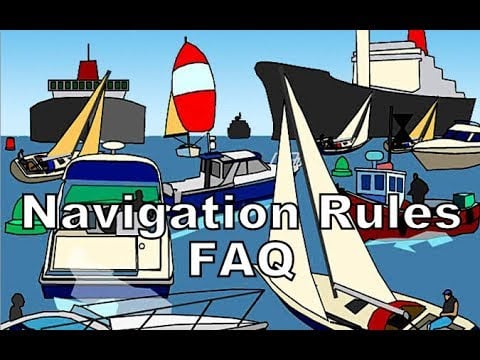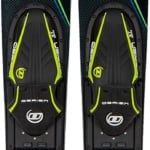When you’re out on the water, it’s important to know the basic navigation rules and right-of-way guidelines to ensure a safe and smooth journey. These rules help boaters avoid collisions and establish a hierarchy of responsibility for giving way to other vessels. Whether you’re a seasoned sailor or a novice boat enthusiast, having a good understanding of these rules can make all the difference in maintaining order and preventing accidents while enjoying your time on the water. So let’s take a closer look at some of the fundamental navigation rules and right-of-way guidelines you need to know.
Introduction to Navigation Rules and Right-of-way Guidelines
Navigation rules and right-of-way guidelines are essential for ensuring safety and order on the water. Whether you are operating a small pleasure craft or a large commercial vessel, understanding and following these rules is crucial. In this article, we will explore the importance of navigation rules, the definition of right-of-way, the purpose of right-of-way rules, and delve into various aspects of navigation, including the international rules, navigational aids and markers, general navigation rules, right-of-way rules, traffic separation schemes, sound and light signals, special cases and exceptions, as well as enforcement and penalties.
Importance of Navigation Rules
Navigation rules serve as a set of guidelines that govern the conduct of vessels operating on waterways, including lakes, rivers, and oceans. These rules are designed to ensure the safety of all waterway users and to prevent collisions. By adhering to navigation rules, you not only protect yourself and your vessel but also promote a safer and more efficient environment for everyone on the water.
Definition of Right-of-way
Right-of-way refers to the privilege of a vessel to proceed ahead of another vessel in a potential encounter situation. It is the responsibility of every vessel operator to understand and respect the rights-of-way defined by the navigation rules. Right-of-way rules are put in place to establish a clear hierarchy for vessel movement and minimize the risk of accidents or collisions.
Purpose of Right-of-way Rules
The purpose of right-of-way rules is to provide a standardized framework for vessels to navigate safely and predictably when encountering each other on the water. These rules outline the responsibilities of different types of vessels and establish a clear order of precedence to prevent confusion and ensure smooth interactions. Understanding and following right-of-way rules contribute to a safer and more efficient waterway experience for everyone involved.
International Rules of Navigation
To ensure consistency and uniformity, the International Rules of Navigation, also known as the COLREGs (Convention on the International Regulations for Preventing Collisions at Sea), have been established. These rules apply to all vessels navigating international waters and have been adopted by many countries as part of their national regulations.
Application of International Rules
The International Rules of Navigation apply to vessels operating on the high seas and all connected waters, including navigable rivers and lakes. They establish the basic principles of navigation and right-of-way and are intended to prevent collisions between vessels. It is vital for all mariners, regardless of their vessel size or type, to familiarize themselves with these rules to ensure safety at sea.
General Responsibility Rule
The General Responsibility Rule, also known as Rule 2, emphasizes the importance of prudent seamanship and the need for all vessel operators to maintain a proper lookout. It places the responsibility on every mariner to navigate with due regard to the prevailing circumstances, including visibility, traffic density, and the capabilities of their own vessel.
Safe Speed Rule
The Safe Speed Rule, as outlined in Rule 6 of the International Rules of Navigation, requires every vessel operator to navigate at a safe speed appropriate for the prevailing conditions. This rule takes into account factors such as visibility, traffic density, maneuverability, and the presence of navigational hazards. Operating at a safe speed allows for better control of the vessel and enables timely responses to potential dangers.
Proper Lookout Rule
The Proper Lookout Rule, defined in Rule 5, mandates that every vessel must maintain a proper lookout at all times, both visually and by all available means. This rule ensures that every operator remains aware of their surroundings and is vigilant for potential risks or hazards. Maintaining a proper lookout is crucial in detecting and avoiding other vessels, navigational hazards, and changes in the environment.
Navigational Aids and Markers
Navigational aids and markers are essential tools for mariners to safely navigate and determine their position on the water. These aids come in various forms, such as buoys, beacons, and lights, and convey important information about water conditions, hazards, and navigational routes.
Types of Navigational Aids
There are several types of navigational aids, each serving a specific purpose. Lateral markers, cardinal markers, preferred channel markers, and safe water markers are some of the most common types. Understanding the characteristics and meanings of these aids is crucial for proper navigation and adherence to right-of-way rules.
Lateral Markers
Lateral markers, consisting of buoys or beacons, indicate the sides of a channel or fairway. Red markers are used for the starboard (right) side of the channel when proceeding in the upstream direction, while green markers are used for the port (left) side. These markers provide valuable information to mariners, allowing them to stay within the designated channel and avoid shallow areas or potential obstacles outside the channel.
Cardinal Markers
Cardinal markers, characterized by their distinctive yellow and black color scheme, represent the four cardinal directions: north, south, east, and west. These markers indicate the safest side to pass when navigating in relation to shallow areas or hazards. By identifying the direction of the hazard, mariners can navigate around it while remaining in safe waters.
Preferred Channel Markers
Preferred channel markers typically consist of red and green buoys and are used to indicate the primary path within a waterway. These markers guide mariners through channels that may have multiple entrances or intersections. Following the designated path indicated by preferred channel markers helps maintain safe and efficient operation on the water.
Safe Water Markers
Safe water markers, often seen as white buoys or beacons with red horizontal bands, indicate the presence of navigable water on all sides. These markers help mariners identify areas where vessels can safely navigate without the risk of running aground or encountering shallow depths.
General Navigation Rules
In addition to right-of-way rules, there are several general navigation rules that mariners must observe to ensure safe and efficient operation on the water.
Prudent Seamanship
Prudent seamanship entails using good judgment, experience, and knowledge to navigate safely in various conditions. It involves assessing the situation, considering the capabilities of your vessel, and making informed decisions that prioritize the safety of yourself, your passengers, and other vessels in the vicinity.
Avoiding Collisions
Preventing collisions is a fundamental principle of navigation. Vessel operators must use all available means to avoid potential collisions, such as maintaining situational awareness, adhering to right-of-way rules, and taking evasive actions when necessary. A proactive and vigilant approach to navigation can significantly reduce the risk of accidents and ensure the safety of all waterway users.
Operating in Close Proximity
When operating in close proximity to other vessels, maintaining a safe distance is crucial. Proper spacing ensures maneuverability and reduces the risk of collisions. It is essential to be aware of the size, speed, and handling characteristics of the vessels around you and adjust your own course and speed accordingly to maintain a safe distance.
Maintaining a Proper Course
Keeping a steady and predictable course is of utmost importance when navigating on the water. Abrupt changes in speed or direction can create confusion and increase the likelihood of accidents. Maintaining a proper course ensures that other vessels can anticipate your movements and plan their own actions accordingly.
Right-of-way Rules
Right-of-way rules establish the hierarchy of vessel movement in different situations and provide clarity on whose responsibility it is to yield. These rules are intended to promote safe and orderly navigation, minimize the risk of collisions, and ensure the smooth flow of vessel traffic.
Overview of Right-of-way
In general, vessels using engines have a higher right-of-way than sailing vessels. However, these rules may vary depending on specific circumstances and the type of encounter. it is essential to familiarize yourself with the specific right-of-way rules for different types of vessels.
Vessels Using Engines
Vessels using engines generally have the right-of-way over sailing vessels. If a powered vessel and a sailing vessel are on collision courses, the sailing vessel should give way to the powered vessel. However, it is crucial for powered vessel operators to maintain a proper lookout and be prepared to take evasive action if necessary.
Sailing Vessels
Sailing vessels, while required to give way to powered vessels, have their own right-of-way rules. When two sailing vessels are on a collision course, the vessel on the starboard tack (with the wind coming from the right side) has the right-of-way and should maintain its course. The vessel on the port tack (with the wind coming from the left side) should give way and alter its course to avoid a potential collision.
Meeting and Crossing Situations
When two vessels are approaching head-on, crossing paths, or in a similar situation where their courses may intersect, specific right-of-way rules apply. These rules help determine which vessel should give way and which should maintain its course. It is essential to understand these rules and act accordingly to prevent collisions.
Overtaking
When overtaking another vessel, the vessel intending to overtake has the responsibility to keep clear and provide sufficient space for the overtaken vessel. The overtaken vessel should maintain its course and speed, allowing the overtaking vessel to pass safely. Clear and timely communication between the vessels is crucial to ensure a smooth and safe overtaking maneuver.
Risk of Collision
In situations where there is a risk of collision, all vessels have a duty to take immediate and proper action to avoid a potential accident. This may include altering course or speed, signaling intentions through sound or light signals, or taking other appropriate evasive actions. The paramount concern in such situations is to prevent a collision at all costs.
Traffic Separation Schemes
Traffic separation schemes are designated areas in busy waterways where vessels are required to follow specific routes and maintain separation to reduce the risk of collisions. These schemes are especially common near major ports and congested shipping lanes.
Definition and Purpose of Traffic Separation Schemes
Traffic separation schemes are established to manage vessel traffic in areas of high traffic density or other navigational challenges. They aim to provide clear and orderly routes for vessels to follow, minimizing the risk of collisions and promoting the efficient flow of maritime traffic.
Entry and Exit of Schemes
Entering and exiting traffic separation schemes require careful navigation and adherence to specific rules. Vessels must approach the entry and exit points at designated angles, yield to vessels already in the traffic separation scheme, and follow the prescribed routes indicated by the navigational aids.
General Navigation within Schemes
Within traffic separation schemes, vessels must remain within the designated traffic lanes and comply with the specified traffic flow direction. Vessel operators should be vigilant for other vessels, maintain a proper lookout, and communicate intentions clearly to ensure safe navigation within the scheme.
Sound and Light Signals
Sound and light signals are vital communication tools used by vessels to convey intentions, warnings, and requests for action to the surrounding watercraft. These signals are standardized internationally and provide a means of communication even in situations where visibility is reduced.
International Sound Signals
International sound signals consist of short and prolonged blasts of sound produced by vessel-mounted horns or whistles. These signals convey various messages, such as altering course, indicating danger, or requesting other vessels to take specific actions. Familiarizing yourself with these sound signals enables effective communication on the water.
International Light Signals
International light signals, displayed by vessels at night or in conditions of reduced visibility, are used to communicate important information to other vessels. These signals indicate a vessel’s status, intentions, and requests for action. Understanding and recognizing these light signals are crucial for maintaining safe navigation in low visibility conditions.
Special Cases and Exceptions
In certain scenarios, specific rules and considerations apply to vessels operating under restricted visibility, fishing vessels, commercial vessels, anchored or moored vessels, and within restricted areas. These cases require additional caution and adherence to specialized regulations.
Restricted Visibility
In conditions of restricted visibility, such as fog or heavy rain, vessels are required to take extra precautions to prevent collisions. Reduced speed, the use of navigation lights, and sounding appropriate signals are some of the necessary measures to enhance safety during periods of limited visibility.
Fishing Vessels
Fishing vessels have unique operating characteristics and require special considerations. When encountering fishing vessels, mariners must give them a wide berth and take appropriate actions to avoid interfering with their fishing operations. Respect for fishing gear, vigilance, and clear communication are essential when sharing waterways with fishing vessels.
Commercial Vessels
Commercial vessels, such as large cargo ships or passenger vessels, may have certain limitations in their maneuverability due to their size and handling characteristics. When operating in close proximity to these vessels, it is important to exercise caution, provide ample space for maneuvering, and be aware of any potential restrictions communicated by the commercial vessel.
Anchored or Moored Vessels
Anchored or moored vessels are stationary objects on the water with limited maneuverability. It is the responsibility of other vessels to keep a safe distance and take appropriate actions to avoid colliding with these vessels. Give-way vessels must yield to anchored or moored vessels and ensure a safe passage while maintaining a proper lookout.
Restricted Areas
Certain waterways may have designated restricted areas where entry is prohibited or restricted due to safety concerns or the presence of hazardous conditions. These areas are typically marked by buoys, beacons, or other navigational aids. Vessel operators must respect these restrictions and avoid entering or passing through designated restricted areas.
Enforcement of Navigation Rules
The enforcement of navigation rules falls under the jurisdiction of maritime law enforcement agencies and authorities responsible for ensuring compliance. These agencies have the authority to conduct patrols, inspections, and investigations related to navigation rule violations. Vessel operators must cooperate with enforcement officials and adhere to their instructions while on the water.
Penalties and Consequences
Violations of navigation rules can result in penalties and consequences, ranging from warnings and fines to vessel detention, license suspension, or legal action. The severity of the penalties may vary depending on the nature and severity of the violation, previous history of non-compliance, and local regulations. Understanding the potential consequences serves as an additional incentive to follow navigation rules and act responsibly on the water.
Conclusion
Following navigation rules and right-of-way guidelines is essential for promoting safety and responsibility on the water. Understanding and adhering to these rules ensure the well-being of all vessel operators, passengers, and other waterway users. By familiarizing yourself with navigation rules, maintaining a proper lookout, and consistently practicing prudent seamanship, you can contribute to a safer and more enjoyable experience for all. Stay informed, be responsible, and exercise caution to help create a harmonious maritime environment where everyone can navigate with confidence.





